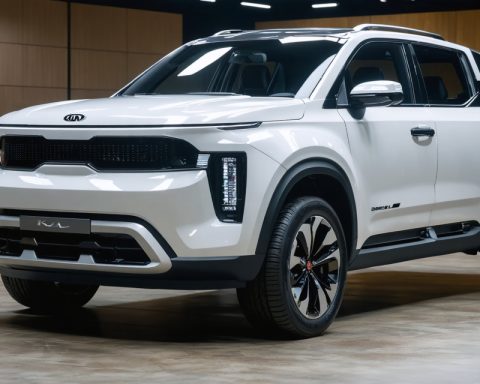In an age where technology dominates daily life, the world of luxury watches is undergoing a transformative evolution that few could have predicted. Though renowned for their tradition and precision, these timepieces are now at the forefront of innovation and sustainability, redefining what it means to be luxury in the 21st century.
The New Wave of Craftsmanship
While iconic Swiss brands continue to lead the market, an exciting renaissance is taking place as independent watchmakers gain international attention. In regions like Britain and Germany, artisans are reviving traditional techniques, creating unique watches that embody local culture. These workshops not only provide skilled jobs but also infuse towns with a renewed sense of cultural pride. This shift raises intriguing questions on whether boutique craftsmanship could chart a new path for the luxury watch industry.
Building Community Through Craft
As watchmaking becomes a focal point of regional identity, it also cultivates community strength. Educational programs aimed at training the next generation of artisans have been established, promoting social cohesion through shared cultural achievements. Collectors and enthusiasts converge in clubs and exhibitions, turning watchmaking into a vibrant, communal activity that fosters lasting connections.
Sustainability: A Need or a Novelty?
In response to the growing demand for ethical production, luxury watchmakers are exploring sustainable practices. From recycled materials to eco-friendly manufacturing, the industry is scrutinizing its environmental impact. However, it remains to be seen if these initiatives herald genuine change or simply serve as marketing strategies to attract conscious consumers.
Ultimately, as luxury watches continue their journey into the future, they invite us to ponder their evolving role—not just as instruments of time, but as icons that meld tradition with innovation, craftsmanship with community, and luxury with sustainability.
The Eco-Evolution of Luxury Timepieces
In the modern era of burgeoning technological advances, the luxury watch industry is reimagining itself, integrating principles of innovation and sustainability into its core. Traditionally celebrated for their precision and timeless elegance, these exquisite timepieces now serve as a nexus of eco-conscious advancement, challenging what connoisseurs expect from luxury in the 21st century.
The Environmental Impact of Watchmaking
The move towards sustainable practices in the luxury watch industry marks a significant shift, spotlighting the environmental consequences of production processes historically steeped in opulence rather than eco-friendliness. The creation of a single luxury watch can involve substantial resource consumption and waste generation. This includes the extraction of precious metals, the emission of greenhouse gases during manufacturing, and the disposal of industrial waste.
Pioneering brands and artisans have started to address these issues by adopting eco-friendly practices—utilizing recycled materials, implementing energy-efficient manufacturing processes, and ensuring traceability of ethically sourced materials. Such efforts potentially reduce the carbon footprint of watchmaking and set new environmental benchmarks for luxury goods.
Economic Implications and Community Revitalization
On an economic level, the rise of sustainable watchmaking recalibrates the global luxury watch market dynamics. By fostering independent watchmakers in countries like Germany and Britain, the industry breathes new life into local economies, promoting job creation, and enhancing regional cultural pride. These independent artisans, with their commitment to sustainability, embody a shift toward a more localized, environmentally responsible economic model in the luxury sector.
This grassroots innovation is reflected in community-building initiatives, where watchmaking becomes a central pillar of regional identity. As towns embrace this craft, they catalyze social cohesion and inspire the next generation through educational programs focused on artisanal skills. This not only strengthens local economies but also lays the groundwork for a richer, culturally infused global heritage of craftsmanship.
The Worldwide Shift Towards Conscious Consumerism
The transformation seen in the luxury watch industry is a microcosm of a broader global trend: mindful consumption. As consumers grow increasingly conscious of their environmental impact, their purchasing decisions favor brands that espouse sustainability. This emerging paradigm positions eco-friendly luxury watches at the intersection of tradition and modernity, meeting the zeitgeist of contemporary ethical engagement.
In the future, this trend could influence other luxury sectors, encouraging a reevaluation of legacy practices worldwide. As a result, luxury might be redefined by the values it endorses—where sustainability becomes synonymous with status, fostering a new world where ethics enrich opulence.
Ultimately, the eco-evolution of luxury watches is a harbinger of change, not only in the industry but in the broader narrative of sustainable luxury. It challenges humanity to consider how traditional elegance and modern responsibility can coalesce, shaping a future that celebrates innovation without sacrificing environmental stewardship. This intersection of legacy and progress offers a promising blueprint for a sustainable global economy harmonious with the planet we cherish.
Luxury Watches: Craftsmanship, Innovation, and Sustainability in the Modern Era
The luxury watch industry is poised at an exciting intersection of tradition and modernity, where art and innovation converge to chart remarkable new paths. As this transformation unfolds, let’s explore the trends, technologies, and challenges shaping this luxury sector.
Market Trends and Analysis
The global luxury watch market is witnessing significant shifts due to changing consumer preferences and evolving demographics. Younger buyers, particularly Millennials and Gen Z, are expressing interest in timepieces that blend heritage with cutting-edge technology. This dynamic is prompting established brands and new entrants alike to explore fresh avenues, including customizable options and limited edition releases, to capture these markets.
Technological Innovations
Technology continues to revolutionize the watch industry. Advancements in materials science have led to the development of ultra-lightweight yet durable watch components. AI-driven design tools are enabling more intricate and precise creations, fostering an unprecedented level of detail and uniqueness in watch design. Meanwhile, the integration of smart features into luxury timepieces is providing consumers with the best of both worlds: the elegance of traditional watches with the functionality of modern technology.
Pros and Cons of Boutique Craftsmanship
The resurgence of boutique watchmaking brings an array of advantages and distinct challenges. On the plus side, these workshops often create highly distinctive designs, with a level of personalization that mass production cannot match. They contribute to local economies by creating skilled jobs and fostering cultural pride. However, limitations arise in terms of scalability and pricing, with bespoke pieces often commanding high premiums due to their labor-intensive production processes.
Sustainability Innovations and Challenges
Luxury watchmakers are increasingly investing in sustainable materials and practices. From the use of recycled metals and responsibly-sourced gemstones to developing solar-powered mechanisms, the industry is taking steps towards reducing its ecological footprint. Yet, the question lingers—are these efforts truly impactful or simply greenwashing tactics? Transparency in sourcing and manufacturing processes will be key in convincing informed consumers of the commitment to genuine sustainability.
Comparisons: Traditional vs. Smart Luxury Watches
Traditional luxury watches boast timeless appeal, exuding elegance and craftsmanship. In contrast, smart luxury watches offer connectivity and multifunctionality, appealing to tech-savvy individuals who seek modern conveniences. The choice between the two often hinges on personal preference, lifestyle needs, and the statement one wishes to make.
Future Predictions
Looking ahead, the future of luxury watches will likely be shaped by the integration of AI and blockchain technologies to enhance personalization and authentication, respectively. Furthermore, as sustainability becomes an increasingly pressing concern, we can expect more rigorous industry standards and consumer demands for transparency in production methods. This will drive companies to innovate ethically, reinforcing the industry’s evolution as one that values both tradition and progress.
For further insights into the dynamic world of luxury watches, you might visit reputable sources like Hodinkee or WatchPro. These platforms offer extensive coverage on market trends, new releases, and expert reviews, keeping enthusiasts and consumers informed.












